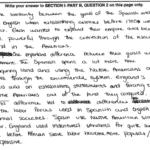Practice, practice, practice. If you’ve read some of my other blog posts on preparing for the APUSH exam, you know that you have to practice with AP-style questions. This blog post will provide those APUSH practice questions (and detailed answers!) for you; keep reading!
First: types of APUSH questions
The APUSH exam will ask you to answer one of four types of questions:
1. The Multiple Choice Question
2. The Short Answer Question
3. The Free Response Question
4. The Document Based Question
This blog post will not get into detailed strategies about how to answer those types of questions. If you are unsure, check out the links to other Magoosh APUSH content above.
This blog post will focus on questions that could be asked on an APUSH exam about the Great Depression and WWII. If you need an overview of those concepts before you tackle these questions, check out some of these resources below.
Resources
1. Crash Course Videos
2. The Great Depression from George Washington University
3. Various content from Gilder Lehrman
You could likely find more, but this should be a good place to get started if you need a refresher.
For this post, I will be giving you 2 multiple choice questions and 1 short answer question. These questions will not be about the Great Depression or World War II as two distinct events in history, but will ask you to compare and contrast, synthesize, or identify patterns throughout history. This is what the APUSH exam will require from you, so this is what we will practice. Good luck!
And happy studying!
Practice Questions: The Great Depression and WWII
From APUSH Practice Exam
“The peace-loving nations must make a concerted effort in opposition to those violations of treaties and those ignorings of humane instincts which today are creating a state of international anarchy and instability from which there is no escape through mere isolation or neutrality…Those who cherish their freedom and recognize and respect the equal right of their neighbors to be free and live in peace, must work together for the triumph of law and moral principles in order that peace, justice and confidence may prevail in the world. There must be a return to a belief in the pledged word, in the value of a signed treaty.
There must be recognition of the fact that national morality is as vital as private morality.”
President Franklin Roosevelt, Quarantine Speech, 1937
The excerpt best reflects an effort by Roosevelt to
A. encourage the ratification of the Treaty of Versailles
B. promote the acquisition of new territories abroad
C. contain the spread of Soviet-dominated communism
D. overcome opposition to participation in the impending Second World War
Correct Answer:
D; Roosevelt begins this excerpt by stating that any “peace-loving nation” has a moral imperative to stop nations who oppose international treaties. Now, while this is not a World History exam, you should note that in July of 1937, Japan invaded China (beginning the war in the Pacific). Hitler’s Germany had been taking over territory in Europe the year before (by militarizing the Rhineland). But these acts of aggression were not enough to get people behind the Second World War. Roosevelt, instead, used rhetorical devices, such as appealing to a sense of obligation and duty to common values and the capacity of human empathy to swing support in his favor. However, the United States was deeply isolationist at this time, and protestors of the war used this speech to double down on their views. Famous comic-strip creator, Percy Crosby, took out a two-page advertisement in the New York Sun to critique Roosevelt, saying:
…Like a mirror, Roosevelt reflects his surroundings: if a fireplace crackles with burning logs, a mirror will, if facing it, reproduce every part of it, but if we need to warm our hands, we do not go to the looking glass, but rather we go to the fireplace. If the licking flames flash out of the fireplace, darting toward the curtains, sending them in a blaze, we do not squirt a hose at the mirror. Therefore, the purpose of this chapter, as well as the whole book, is to hit at those whom Roosevelt reflects.
There is nothing so dependable as a rousing, good war to keep a “president” in the White House. If this country should become embroiled in another foreign war, it is customary not to change presidents during such crisis, or ”never change horses in the middle of a stream”…
This anti-war sentiment died down after the attack on Pearl Harbor in 1941, but it was never entirely absent.

Although Crosby was best known for his Skippy cartoon, he did not shy away from political discussions. Source here.
From the Stanford History Education Group.
“This social security measure gives some protection to 30 million of our citizens who will receive direct benefits through unemployment compensation, through old-age pensions, and through increased services for the protection of children and the prevention of ill health. We can never insure 100 percent of the population against 100 percent of the ups and downs of life, but we have tried to pass a law which will give some protection to the average citizen and to his family against the loss of a job and against poverty-ridden old age.”
President Roosevelt, August 14, 1935
“The point that I am making is that in order for a person to qualify for Social Security, taxes must be paid on behalf of this person before he turns 60. Now, for the benefit of Negroes, I want to ask, who would be left out by that rule?
First, and very serious, Negro sharecroppers and cash tenants would be left out. We all know that the Negro sharecropper and the Negro cash farm tenant are at the bottom of the economic scale. He is not employed. There is no relation of master and servant by which he gets wages on which a tax could be collected. Therefore this population is left out from the old-age annuity, and that represents approximately 490,000 Negroes.
Next, domestic servants are excluded from the act because the system of employing domestic servants is so loose. In addition to that, this old-age annuity does not provide for unemployed persons. I do not need to argue to the committee that Negroes have suffered from unemployment more than any other class of the community.”
Excerpt from the testimony of Charles H. Houston, representing the NAACP, to the House Ways and Means Committee on the Economic Security bill, February 1, 1935.
Answer (a), (b), and (c)
(a) Briefly describe ONE major difference between Roosevelt’s and Houston’s response to the Social Security Act.
(b) Pick ONE line from either Roosevelt’s or Houston’s speeches that represents the difference you described in part (a) and explain.
(c) Briefly describe ONE major consequence of the situation described in Houston’s account regarding African-American workers in the South that is not explained by these two documents.
Possible answers:
(a) Roosevelt believes that the Social Security Act covers the greatest number of people that it possibly could, but Houston believes that the Act systematically excludes African Americans by leaving out the professions those individuals disproportionately occupy.
(b) When Roosevelt says, “we have tried to pass a law which will give some protection to the average citizen and to his family against the loss of a job and against poverty-ridden old age”, Houston would likely respond to this by questioning the fact that the Social Security Act does not protect the average African American citizen.
(c) One major consequence of the situation described in Houston’s account was an intensification of the Great Migration to the North and West.
Excerpt from this essay found on the Gilder Lehrman site.
“The world the American people tried to exclude after the First World War could not, in the final analysis, be kept at bay. Adolf Hitler and Franklin Roosevelt came to power within weeks of one another…The challenges of the Great Depression and the accomplishments and shortcomings of the New Deal, and of FDR, cannot be understood outside of that framework. In that sense the story of the Great Depression is not simply the story of the American people in a moment pregnant with danger and opportunity; theirs is but part of a larger story of people in every part of the globe who were swept up in the enormous calamities of the Great Depression and, ultimately, World War II.”
David Kennedy, Professor of History at Stanford University
In this historical interpretation, Kennedy argues that
A. As a result of the Great Depression, Americans were content with being isolationists in foreign policy
B. World War II ended the Great Depression
C. To understand the Great Depression and World War II in the United States, you need to look at the events in a global context
D. The Great Depression was a time of opportunity and danger, and the people of the United States met the challenge and seized the opportunity
Correct Answer:
C; Kennedy argues that because certain events happened in tandem (at the same time), national history needs to be understood in the context of global events. The events from 1929-1945 (The Great Depression and World War II) are two such events.




Leave a Reply